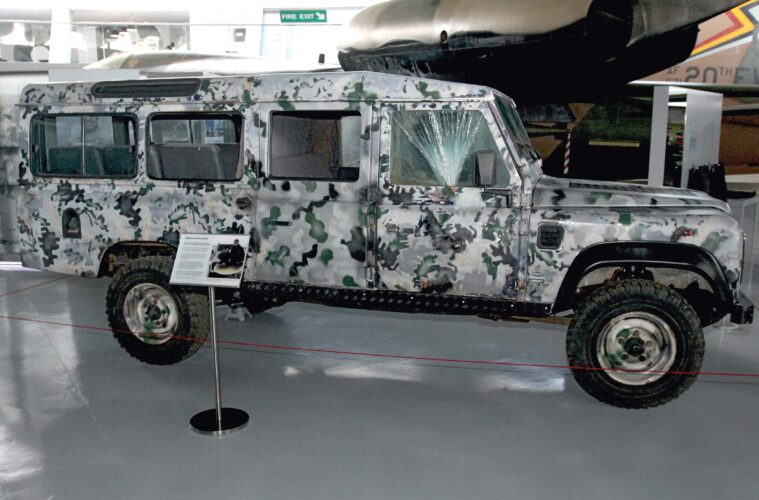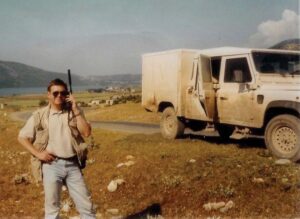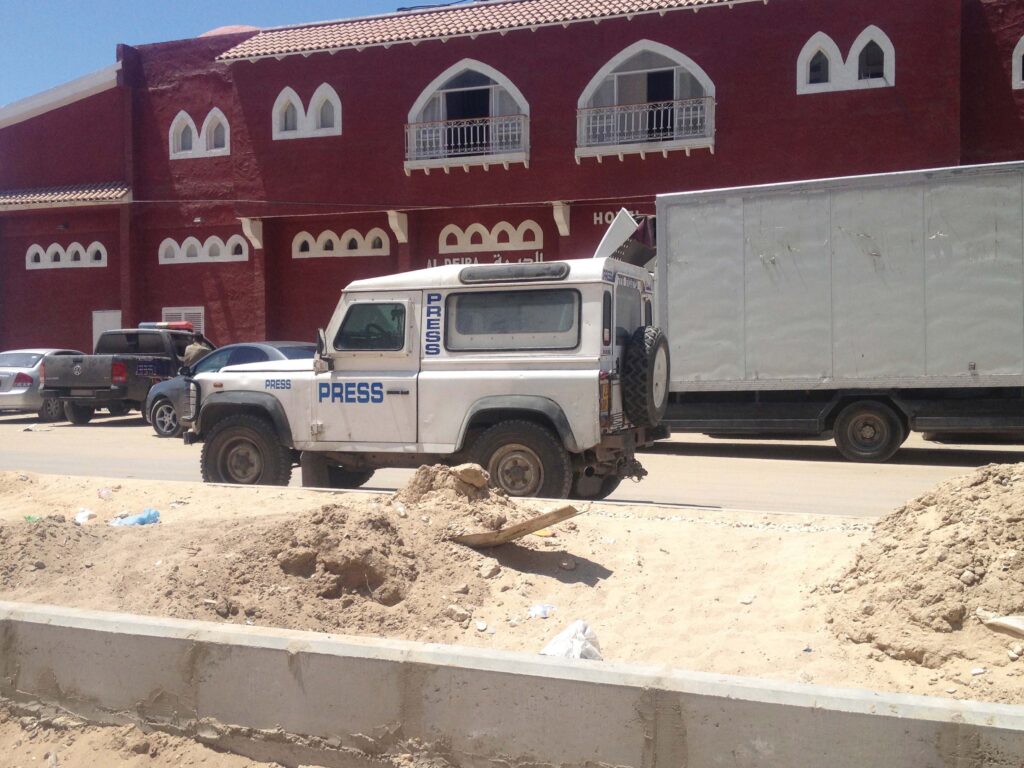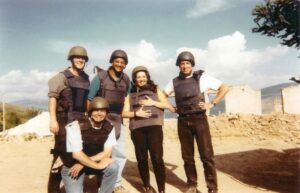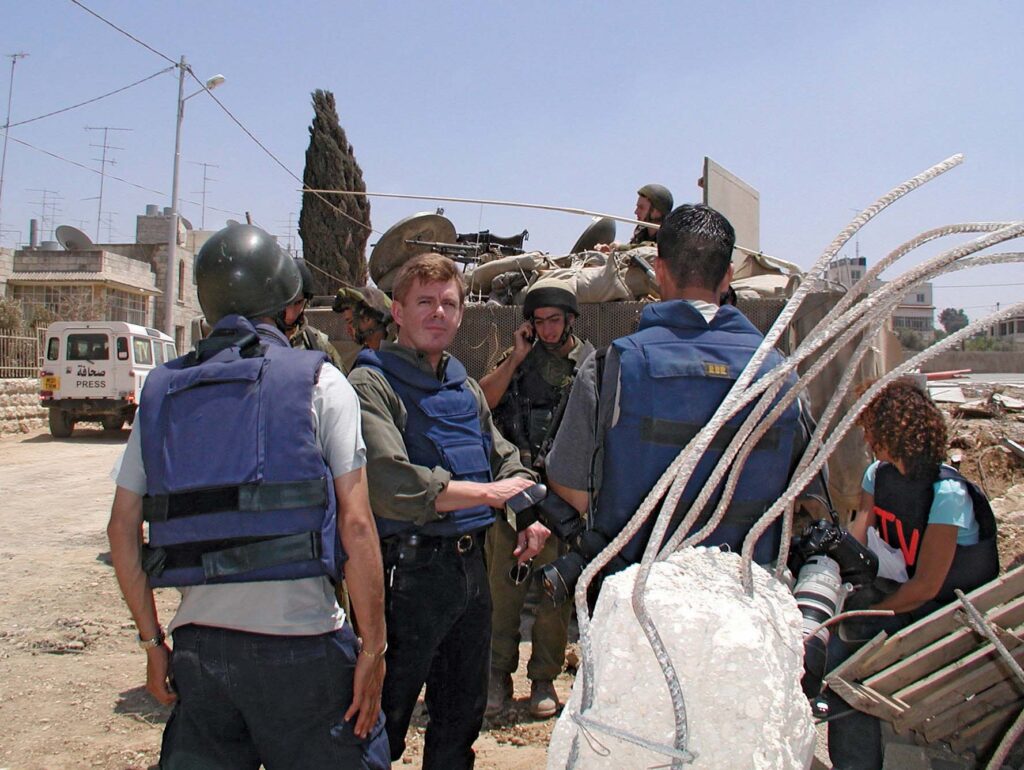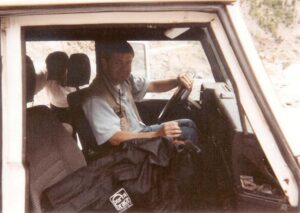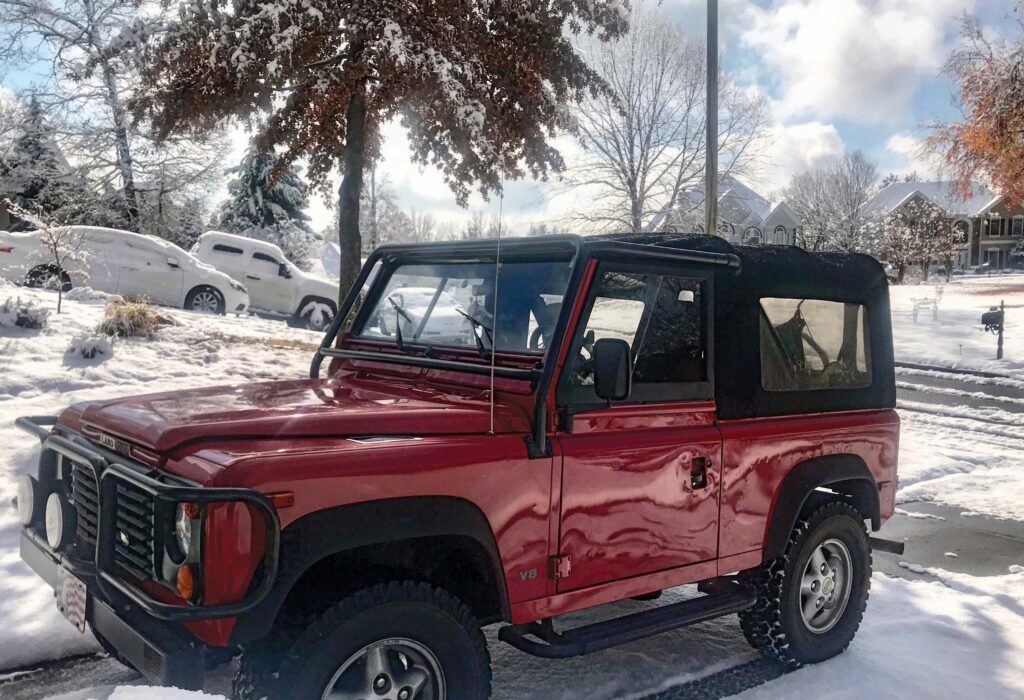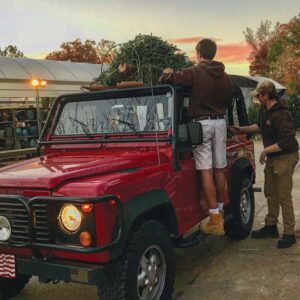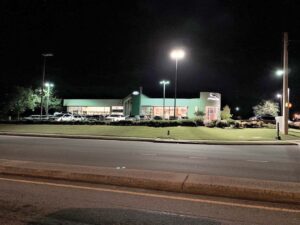From where I sat, the view was breath-taking — but not in a good way.
The Defender 130’s acute nose-down attitude allowed me to see the far edge of the hood and the half mile of thin air stretching after it. Even more troubling, that view was abruptly
interrupted by the rooftops and church spire of a village on the valley floor below.
Outside I could see Leon, my photographer, standing just to the left, his hands spread apart, palms facing each other, showing me how little space remained before the front wheels of our Defender reached the end of the mountainside where that thin air began.
Once more, I gently eased off the emergency brake and let out the clutch with the gear shift firmly in reverse. And again, the wheels, though turning backwards, failed to find purchase, resulting in a counter-productive slide. When I glanced over again, Leon’s hands had moved much closer together, looking as though they were about to clap.
Four of us — our translator, our sound person, the videographer and me, the reporter — were working as a CNN crew on Albania’s border with Kosovo, covering that country’s war with what was then the Federal Republic of Yugoslavia.
We had affectionally named our Defender the “Pizza Truck” due to its large cargo box for hauling equipment. The Foley Specialist Vehicles conversion, [Royden, Essex, UK] had armored only the cab.
CNN had acquired the ironclad Defender in 1992 to protect news crews covering the war in Bosnia. It was one of the network’s first truly armored vehicles, painted white to signal its civilian status. It regularly transported internationally known reporters such as Christiane Amanpour and Nick Robertson during their courageous coverage of a conflict that routinely saw journalists targeted. Besides Bosnia, Albania, Kosovo and Macedonia, the Pizza Truck also saw duty in Chechnya and Afghanistan.
Our mountain site provided a vantage point from which to watch the latest fighting between Serbian forces and members of the Kosovo Liberation Army. However, places like this were no place to be once the sun goes down, so we needed to get off the mountain and back to the shelter of a nearby town.
Leaving it behind was unthinkable. We relied on our Defender to get us up and down the steep terrain, to navigate riverbeds pretending to be roads. It could dip into swales when artillery threatened and shield us from sniper fire.
CNN was not the only network to use modified Defenders. Many journalists covering war fronts have made it their vehicle of choice. In such places, danger can be sudden and can occur in unexpected circumstances. For example, one news team confronted the lawlessness endemic to this part of Albania during this same period. On their way to cover a breaking story, the team came across a roadblock set up by armed bandits who demanded that they turn over their Defender.
Sitting in a modified Defender can make a crew feel impervious to the threats implied by a ragtag militia armed with AK-47s. This vehicle can give you a certain reassurance, even bravado — which these TV sorts allegedly showed by simply smiling back at the would-be car thieves from behind their thick steel plating and heavily laminated glass, impervious to the AKs aimed at them. Those smiles vanished when the bandit leader waved to the nearby tree line where a man pointing an RPG [rocket-propelled grenade] appeared. In retaliation for the crew’s attemted resistance, the bandits stole not only their vehicle but also their clothes. The lesson? An armored vehicle’s greatest weakness is often operator error.
Back at the mountain precipice, I pondered our current position. While we appreciated its safety features, our Defender was known to be a nightmare to drive because it was so heavy. Now that weight conspired with gravity to pull us over the edge.
I ordered everyone else out of the vehicle. Steve, the sound recording engineer, refused, proclaiming his faith in me and our vehicle. I appreciated his support but suspected the real reason he did not bail was the body armor and Kevlar helmet he wore — along with the audio mixer in his lap — which wedged him in too tightly to move.
The day before had produced a different drama on the mountain. At quitting time, we had all climbed aboard the Defender anxious to be gone as the sound of sniper fire began to snap in the air. I was the driver, chosen by the simple fact I was the only one who could drive a stick shift.
I turned the key — the engine cranked but did not catch. I paused and tried again. Same result. “It almost sounds like it’s out of gas,” Steve interjected from his usual spot seated behind me. I looked at the gas gauge in which the needle sat on E; it had set up permanent residence there several weeks ago. So, the tank’s true level at any given time was always a bit of guess work. No worries; there’s a spare tank… all I needed to do was find the lever to switch to it.
The owner’s manual is always a useful source, and conveniently it was in easy reach, as its pages lay scattered haphazardly across the front and back floors. This provided testimony that other TV crews had consulted it in similary desperate times. We found the needed page, but the switch wasn’t in its indicated location. Sometime in the past it had been moved, its current whereabouts unclear. The sun was getting lower and just as I was about to suggest we get out to expand our search, a sniper round pinged the front bumper, a reminder we were not alone.
We went on to dismantle the Defender’s interior while staying firmly crammed within it — lifting seats, probing spaces, peering under floor mats, growing more anxious. It was Gulka, our translator, who found the switch hidden in the the back seat area. We flipped it, said a quick prayer, and turned the key. The engine roared into life and once again, the Defender came to our rescue.
Defenders had saved me many times in places like Kashmir, Lebanon, the West Bank, Gaza, Afghanistan — but this latest cliff-hanger was looking grim. Coming down the mountain, I had chosen to follow a local cowherd on the rutted trail, believing in their wisdom to guide us. But suddenly the cow in front of us jogged right, revealing the danger, giving me just enough time to hit the brakes and pull the emergency hand brake — stopping us breathless and wide-eyed, starring into the wild blue yonder.
Now, once more I looked at Leon’s hands, almost touching, and eased the emergency brake handle while lifting my foot off the clutch; as before the wheels slipped on the loose stone — but this time they found purchase on the rock surface of the cliff edge, lurching us backwards. Once again, the “Pizza Truck” delivered.
It was a life-changing moment, though to be honest, I’ve had many in my line of work.
A month later, now back stateside, I walked into my local Land Rover showroom telling the salesperson I wanted to buy a Defender. “You’re about 5 years too late,” came the reply.
He directed me to the used Defender market. Fortunately, Atlanta has a vibrant one and I found a model I liked listed on Craigslist by a truck driver. I soon became the immensely proud owner of a red ‘95 Defender 90 NAS soft top. It gently leaks on my garage floor to this day, a symbol of a brand bond born out of war. I owe Defender not only my loyalty but my life.
As for the “Pizza Truck,” it went on to other amazing adventures until it suffered a breakdown and unavoidable abandonment in Tora Bora, Afghanistan. A local warlord recovered it and for a while used it for his own transportation. The rig continued to change hands in the fog of war and underwent several makeovers. The equipment box was removed, and seating added along with an unusual camouflage paint job.
Legendary CNN photographer Dave Rust kept doggedly on the Defender’s trail. CNN had granted him custodianship and Rust was determined that this Defender, that had done so much to protect so many of us, should not remain behind. On a return assignment to
Afghanistan, Rust wrangled the Defender back into friendly hands. Thanks to a little help from the Royal Air Force, the “Pizza Truck” arrived home to the UK, retired with honors and now sits at the Imperial War Museum in Duxford, near Cambridge England.
Rest well my friend and many thanks.
Land Rover North Atlanta
Formerly named Land Rover Apharetta, this Hennessy family dealership became one of the first Range Rover North America franchises in 1987 and remains a center of Land Rover enthusiasm to this day.
Service technician Matt Forest reported that Martin’s Defender 90 “is in really good shape, and Martin is a good steward of the Defender.” In a “small world” moment, Matt noted that he bought his current ‘95 Discovery I, now with a 300 Tdi/5-speed drivetrain, from Rovers North’s Zack Griswold.
